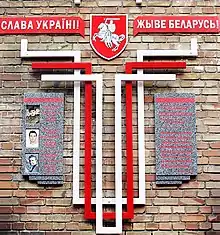Combatants of the war in Donbas (2014–2022)
The combatants of the war in Donbas included foreign and domestic forces.
As of February 2018, the number of southeastern army separatist forces is estimated at 31,000 of which 80% (25,000) are Donbas residents, 15% (≈5,000) are military contractors from Russia and other countries. other countries and 3% (900–1,000) are regular Russian Armed Forces personnel. This ratio has changed significantly from previous years, with "the Russian command gradually filling the armies of the 'republics' with locals".[1] since peaking in 2015.
Separatist insurgents
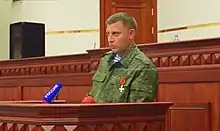

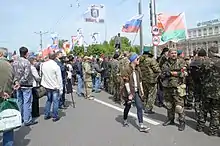
Donbas People's Militia
Igor Girkin, a Russian citizen and FSB officer from Moscow[2] who commanded the Donbas People's Militia in Sloviansk, initially denied Russian involvement in the insurgency.[3] He said his unit was formed during the Crimean crisis, and that two-thirds of its members were Ukrainian citizens. Girkin also said that the Sloviansk insurgents had agreed to work with the leadership of the Donetsk People's Republic, despite some conflict between insurgent groups.[4] According to a spokesman for the Donetsk People's Republic, the militants that occupied Sloviansk were "an independent group...supporting the Donetsk protest",[5] while insurgents in Sloviansk and Kramatorsk identified themselves as members of Pavel Gubarev's Donbas People's Militia.[6] The group's forces at Sloviansk included some professional soldiers amongst their ranks, as well as retired veterans, civilians, and volunteers, while those in Donetsk have been confirmed to include former Berkut special police officers.[7] When asked by The Sunday Telegraph where their weapons had come from, one veteran of the Soviet invasion of Afghanistan nodded at the Russian flag flying from the police station and said: "Look at that flag. You know which country that represents".[7] An insurgent commander in Donetsk, Pavel Paramonov, told journalists he was from Tula Oblast in Russia.[8] In Horlivka, police who defected were commanded by a retired Lieutenant Colonel of the Russian Army,[9] later identified as Igor Bezler. Former Soviet military veteran Vyacheslav Ponomarev, who declared himself mayor of Sloviansk, said that he appealed to old military friends to take part in the militia: "When I called on my friends, practically all of whom are ex military, they came to our rescue, not only from Russia but also from Belarus, Kazakhstan and Moldova."[10]
A former separatist militant corroborated these stories in an interview with Radio Free Europe. He said that fighters, including some Cossack units, arrived from Russia to support the separatists.[11] Another interview with an insurgent from Saint Petersburg was published in Gazeta. He claimed to be fighting voluntarily as part of the Russian Imperial Movement.[12]
In late July 2014, the local support for the militia within the city of Donetsk was estimated to be 70% by a local entrepreneur interviewed by Die Welt.[13] Armed groups affiliated with the Luhansk People's Republic were merged with the Donbas People's Militia on 16 September to form the "United Armed Forces of Novorossiya".[14]
Army of the South-East
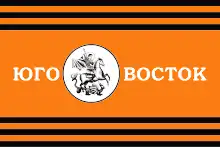
The Army of the South-East (Russian: Армия Юго-Востока, Armiya Yugo-Vostoka) was a pro-Russian militant group that occupied various buildings in Luhansk Oblast.[15] According to The Guardian, their personnel include former members of the disbanded Berkut special police.[15] They were affiliated with the Luhansk People's Republic, but were merged with the Donbas People's Militia on 16 September to form the United Armed Forces of Novorossiya.[14]
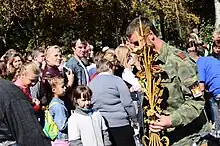
Russian Orthodox Army
The Russian Orthodox Army (Russian: Русская православная армия, Russkaya pravoslavnaya armiya), a pro-Russian insurgent group in Ukraine, originated in May 2014 as part of the insurgency.[16] It reportedly had 100 members at the time of its founding, including locals and Russian volunteers. As fighting between separatists and the Ukrainian government worsened in Donbas, membership rose to 350, and later to 4,000.[17] Notable engagements of the ROA include the June 2014 skirmishes in Mariupol and Amvrosiivka Raion.[18] The headquarters of the ROA is located in an occupied Security Service of Ukraine (SBU) building in Donetsk city.[19] Members swore allegiance to Igor Girkin ("Strelkov"), insurgent and Minister of Defence of the self-declared Donetsk People's Republic. According to the Defence Ministry of Ukraine, the ROA has been in conflict with another pro-Russian militia, the Vostok Battalion, which accused the ROA of looting, and of avoiding combat.[20]
Vostok Battalion

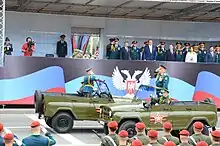
The Vostok Battalion (Russian: Батальон Восток, Ukrainian: Батальйон Схід; lit. "East Battalion") was formed in early May 2014. It is commanded by Alexander Khodakovsky, a defector from the Security Service of Ukraine.[21] Khodakovsky is the chief of the DPR's security service, and of the Patriotic Forces of Donbas, an insurgent battalion.[22]
Khodakovsky said that the "overwhelming majority" of his men came from eastern Ukraine.[23] According to the US government funded Radio Free Europe/Radio Liberty, Vostok reportedly includes former members of the original Vostok Battalion, a special forces unit of the Russian intelligence directorate (GRU) that participated in the Second Chechen and Russo-Georgian Wars. The original battalion was incorporated in 2009 into a Russian Defence Ministry reserve unit that is based in Chechnya.[24] Khodakovsky said he had about 1,000 men at his disposal, and that more "volunteers" with experience in the Russian security sector were expected to join the battalion.[21] A report by Radio Free Europe said that there were suspicions that the battalion was either created directly by the GRU, or that it was at least sanctioned by it.[24] The battalion includes both fighters from Russia and from Ukraine.[25] A BBC News report said that the battalion was composed largely of untrained locals from eastern Ukraine, with a smattering of Russian volunteers.[26] Colombian and United States citizens have volunteered in Vostok battalion.[27][28] A number of the Vostok insurgents were killed at the First Battle of Donetsk Airport. 30 bodies were repatriated to Russia after the fighting.[29] Some of the members said they received salaries of 100 US dollars a week, though they maintained that were only volunteers.[23] An Armenian volunteer in the unit said the battalion was composed of Slavs, and that roughly 80% of militants were from Russia.[30]
By late February 2015, 110 members of the battalion had been killed and 172 wounded in the conflict.[31]
Police and military defectors and deserters
.svg.png.webp)
In May 2014, the acting Ukrainian president Oleksandr Turchynov stated that numerous Ukrainian military and security personnel had joined the separatists, alongside stolen Ukrainian military equipment.[32] In October 2014, Internal Affairs minister Arsen Avakov told journalists that about 15,000 Ukrainian policemen in Luhansk and Donetsk oblasts had defected to the separatists.[33]
Cossacks
Some identified maverick neo-Cossack volunteers,[34] particularly Don Cossacks who live on both sides of the border,[35][36] are participants in the war,[37] along with some self-styled neo-Cossack groups.[38] Several of these Cossacks formed a paramilitary unit called the 'Terek Wolves Sotnia', a reference to a detachment of White emigre Cossacks that fought against the Soviet Union during the Second World War.[39][40] Prominent fighters include Alexander "Boogeyman" Mozhaev (a Russian military veteran from Belorechensk) and the unit's commander, Evgeny Ponomarev.[39][41] Ponomarev was killed in August 2014.[42]
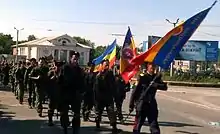
Although Cossack units have been prohibited from crossing the Russian border into Ukraine en masse,[34] it has been reported that Russian elements tacitly support the individual fighters in crossing the border into Ukraine.[41] The Cossacks claim that it is their faith in Cossack brotherhood, Russian imperialism, and the Russian Orthodox Church that has driven them to take part in the insurgency with the aim of conquering what they perceive as "historically Russian lands."[40] Mozhaev also stated that some of the more extreme views of the Cossacks include destroying "the Jew-Masons," who they claim have been "fomenting disorder all over the world" and "causing us, the common Orthodox Christian folk, to suffer."[43] On 25 May, the SBU arrested 13 Russian Cossacks in Luhansk.[44]
Caucasian and Central Asian armed groups
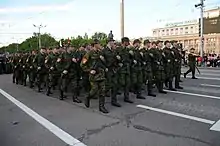
The Foreign Affairs ministry of Ukraine said that the presence of foreign soldiers amounted to "undisguised aggression" from Russia, and "the export of Russian terrorism to our country". "There are grounds to affirm that Russian terrorists funnelled on to the territory of Ukraine are being organised and financed through the direct control of the Kremlin and Russian special forces," the ministry said.[45] To date, reports and interviews have shown the presence of Chechen, Ossetian, Tajik, Afghan, Armenian, and various Russian paramilitary forces operating in Ukraine.[46][47]
Chechen paramilitaries
Chechen paramilitaries were spotted in Sloviansk on 5 May 2014.[48] Chechen president Ramzan Kadyrov threatened on 7 May that he would "send tens of thousands of Chechen volunteers to southern and eastern Ukraine if the junta in Kiev continued its punitive operations."[49] It was reported that Kadyrov engaged in an aggressive recruitment campaign in Chechnya for this operation, and that there were recruitment centres for it in Grozny, Achkhoy-Martan, Znamenskoye, and Gudermes.[50] The Kavkazcenter, the official website of the North Caucasus Islamic insurgency, reported that Chechen authorities had opened recruiting offices for volunteers wishing to fight in Ukraine, and that those offices had suddenly closed.[51] Five lorries crossed the Ukraine-Russia border carrying militants aboard on 24 May, with some reports suggesting among the militants were veteran Chechen soldiers.[52][53] On the following day, the Vostok Battalion arrived in Donetsk in a convoy of eight lorries, each filled with 20 soldiers. Several of the soldiers looked Chechen, spoke the Chechen language, and said that they were from Chechnya.[54][55][56] Two insurgents told CNN reporters that these were Chechen volunteers.[57]
Ramzan Kadyrov denied knowledge of the presence Chechen troops in Ukraine,[58] but a separatist commander later confirmed that Chechens and militants of other ethnicities fought for the Donetsk People's Republic People's Militia.[59] In the aftermath of the First Battle of Donetsk Airport, local authorities said that some wounded militants were Chechens from Grozny and Gudermes. One Donetsk resident said that the presence of Chechen fighters showed "that this war is not clean. It is artificially created. If this is an uprising by the Donetsk People's Republic, what are foreigners doing here?"[46]
Chechen militants interviewed by the Financial Times and Vice News said that they became involved in the conflict on the orders of the Chechen president.[46][45][60] President Kadyrov strongly denied these reports on 1 June.[61] In his statement, he said that there were "74,000 Chechens who are willing to go to bring order to the territory of Ukraine", and that he would not send them to Donetsk, but to Kyiv.[61] As of May 2015, majority of previously pro-Russian Chechen paramilitaries exited the conflict, because of the two known incidents with Zakharchenko and his people, according to Akhmed Zakayev.[62]
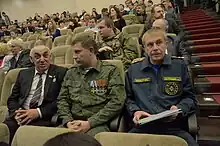
Ossetian and Abkhaz paramilitaries
Starting on 4 May 2014, the United Ossetia Party and the Union of Paratroopers in the pro-Russian breakaway Republic of South Ossetia announced a recruitment drive meant to send veterans of the Georgian-Ossetian conflict to protect "the peaceful population of Ukraine's southeast".[63] Some videos issued by an Ossetian militant group indicated that they were operating in Donetsk.[64] Donbas insurgents interviewed on 27 May admitted that there were 16 fighters from Ossetia operating around Donetsk for at least two months prior.[45] Head of the State Border Guard of Ukraine Mykola Lytvyn said that officials reports indicated the presence of Abkhaz militants as well.[65] Militants from North and South Ossetia were open about their presence in Donbas in June. One militant named Oleg, part of the Vostok Battalion, told reporters "In 2008 they were killing us and the Russians saved us. I came here to pay my dues to them".[21]
Serbian volunteers
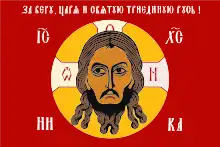
In 2014, it was reported that at least 100 insurgent-affiliated Serbian volunteers are fighting in Ukraine. At that time, they had their own combat unit, named after Jovan Šević, including 45 members of the Chetnik movement,[67] led by Bratislav Živković. According to media reports, by late 2017, this number fell to a few dozen.[68] Serbian volunteer Dejan Berić has appeared in Russian media, which described him as a highly decorated soldier and hero; he has also figured as a member of the press at a press conference of Maria Zakharova in Moscow.[69][70]
From late 2014 until late 2017 Serbia has opened 45 cases against Serbian mercenaries who had been fighting in the war in Donbas and in other military conflicts abroad.[68] In August 2019, Serbian citizen Goran Chirich was placed under arrest by Russian Federation for "illegal crossing of border" from Donbas based on Interpol arrest warrant issued by Serbia, requesting his extradition. In May 2020 his appeal against extradition was denied by a court in Rostov-on-Don based on the fact that Chirich does not have Russian citizenship and so called "DPR passports" are not recognised even in Russia.[71]
Volunteers from other countries
There are reports that volunteers from other countries, including France, Germany, the United States, Italy, Poland, Romania, Spain, and Turkey have fought on the insurgent side.[72][73][74] Around 20 Hungarians have formed their own unit named Legion of Saint Stephen.[74] In February 2015, Spanish police arrested eight Spaniards suspected of fighting alongside pro-Russian militants.[75][76][77] Commenting on other foreign fighters, the suspects said that "They were paid neither travel expenses nor a salary, but they were received with open arms [...] We all want the same: social justice and the liberation of Russia from the Ukrainian invasion."[78] The German newspaper Welt am Sonntag reported that more than 100 German citizens were fighting alongside pro-Russian militias in eastern Ukraine. Most of them were ethnic Germans from the former Soviet republics, and some had served in the Bundeswehr. According to the paper, a 33-year-old German citizen originally from Kazakhstan was killed in action by shrapnel during the battle of Debaltsevo, on 12 February 2015.[79] Kazakhstan has given prison sentences of three to five years to its citizens who have fought for pro-Russian militias in Ukraine.[80] In February 2016, Moldova stated that pro-Russian forces in Ukraine had recruited dozens of its citizens with the offer of money, with one individual saying he had been promised $3,000 a month.[81] Two Moldovan mercenaries received three-year prison sentences and eight others were under investigation.[81]
Russian forces
While Russia denied its troops were operating in Ukraine between 2014 and 2022, OSCE observers have witnessed Russian troops operating in Ukraine identifying themselves as Russian servicemen.[82] A paper released by the Royal United Services Institute estimated that 9,000–12,000 Russian troops had been deployed to parts of eastern Ukraine in early 2015, with 42,000 troops having been involved in the combined service rotation.[83][84] On 17 December 2015 President Vladimir Putin stated in a response to a question about the detained Russian GRU agents held in Ukraine that Russia had "people (in Ukraine) who work on resolving various issues there, including in the military sphere." However, he went on to state "that doesn't mean there are regular Russian troops there." This was generally taken as an admission by Russia that its special forces were involved in the conflict.[85] According to Russian former prime minister of the DNR Alexander Borodai, 50,000 Russian citizens had fought for separatist forces by mid 2015.[86][87]
As of February 2018, the number of separatist forces were estimated at 31,000 out of which 80% (25,000) were Donbas residents, 15% (≈5,000) were military contractors from Russia and other countries and 3% (900–1,000) were regular Russian armed forces personnel. This proportion has significantly changed from earlier years, with "Russian command gradually filling up the military of the 'republics' with locals"; the primary driver being that salaries are no longer attractive for contractors from Russia, but highly attractive as stable source of income in economically impaired separatist territories. Regular soldiers in Donbas are offered anything from 15,000 and officers 25,000 RUB, while in the Russian army these respective earnings are 20,000 and 68,000 RUB. Russian forces still occupy most command positions as well as operate advanced weapons, such as electronic warfare units.[1] In separate interviews given to Maksim Kalashikov in 2020, Igor Girkin and Pavel Gubarev openly admitted that the LDPR armed forces are only playing a role of "cover" for the regular armed forces of the Russian Federation, who are keeping the territories under Russian control.
OSCE monitors periodically record convoys of military trucks crossing through unmarked locations along the Russian-controlled border, usually overnight. OSCE statements and spot reports are criticised in Ukraine as they vaguely reports military "convoys leaving and entering Ukraine on dirt roads in the middle of the night, in areas where there is no official crossing" without explicitly mentioning Russian armed forces.[88][89] OSCE monitoring frequently faces access restrictions and signal jamming of the monitoring UAVs. In 2021 OSCE reported that 62.5% long-range UAV flights "encountered GPS signal interference" with jamming so strong, it occasionally prevented UAV from even taking off.[90] OSCE has on numerous occasions reported presence of Russian electronic warfare equipment in the separatist-controlled areas[91][92][93] including specifically anti-UAV Repellent-1 systems.[94]
After the full-scale invasion on Ukraine in 2022 a number of prominent LDPR activists started openly talking about involvement of Russian regular armed forces and GRU units described as "private military companies" since 2014.[95] In 2023 interview Aleksander Khodakovsky described how in 2014 the Russian forces saved the separatist units from losing to Ukrainian army, noting that "it was not politically correct to discuss that involvement at that time" and helped expand their zone of control to Novoazovsk, Starobilsk, Telmanove and other regions.[96]
Private military companies
Russia declaratively utilized private military companies (PMC) in the conflict, but as no such legal entity even exists in Russia law, these were usually controlled by FSB and GRU. Among the Russian PMCs operating in Eastern Ukraine, main actors were Wagner Group, MAR and E.N.O.T. Corp. Other include: RSB-Group, ATK-GROUP, Slavonic Corps Limited, Cossacks.[97][98]
Ukrainian forces
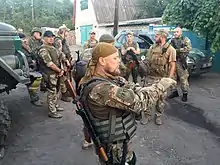
Armed Forces of Ukraine
The Armed Forces of Ukraine are the primary military force of Ukraine, and have taken a leading role in countering DPR and LPR forces. In 2014, the Armed Forces was said to be "in a disastrously impoverished state",[99] and "had almost no training in confronting an internal land battle".[100] It has been widely criticised for its poor equipment and inept leadership, forcing Internal Affairs Ministry forces like the National Guard and the territorial defence battalions to take on the brunt of the fighting in the first months of the war.[99][100]
Following its independence from the Soviet Union in 1991, Ukraine inherited all Soviet military equipment and formations that had been stationed on its territory. Over the years preceding the start of hostilities in Donbas, the Armed Forces were systematically downsized, and became largely dilapidated.[101] Soviet weaponry was not replaced or upgraded, leaving the Armed Forces with outdated and poorly maintained equipment.[101] As an example, the Soviet military units never utilised ballistic vests, and hence, when the war in Donbas started, the Armed Forces of Ukraine had none. Whilst there is a vibrant defence industry in Ukraine, the equipment it produces is for export, and had not been used to equip the Armed Forces prior to the war.[101] Amidst the Crimean Crisis on 11 March 2014, then Defence Minister Ihor Tenyukh said that "de facto only 6,000 [soldiers] are in combat readiness".[101] According to a report by The Ukrainian Week, 90–95% of the Armed Forces' equipment in July 2014 was outdated or in poor repair. In addition, professional soldiers were in short supply, forcing conscripts and volunteers to fill battalions.[101]
To counter equipment shortages, a powerful civil volunteer movement appeared. Teams of volunteers established crowdfunding centres that provide the soldiers with diverse support: from food and medicines to equipment like bulletproof vests, spaced armour, thermographic cameras and unmanned aerial vehicles.[102][103] Other volunteers help the injured soldiers or search captives and the killed ones. Such volunteer centres work in all large cities and many small settlements of Ukraine, except those which aren't controlled by government.[104]
In 2016, Ukraine was struggling to recruit conscript servicemen, due to significant evasion of conscription, to replace demobilising soldiers including volunteers. This followed negative publicity about nutrition and equipment deficiencies in the conflict zone.[105] By mid-April 2016, 127,363 soldiers and volunteers had received veteran status.[106]
By February 2018, the Ukrainian Armed Forces were larger and better equipped than ever before, numbering 200,000 active-service military personnel and most of the volunteer soldiers of the territorial defence battalions have been integrated into the official Ukrainian army.[107]
National Guard of Ukraine
The National Guard of Ukraine was re-established on 13 March 2014, amidst rising tensions in Ukraine during the Crimean crisis.[108] It is a part of the Ministry of Internal Affairs. It was re-established to replace the Internal Troops of Ukraine, and is based on that force.
Ministry of Internal Affairs
The Ministry of Internal Affairs is commonly known as the militsiya, and is the primary police force in Ukraine. It is led by the Internal Affairs Minister, Arsen Avakov, a key figure in leading the counter-insurgency operations in the Donbas.
Security Service of Ukraine
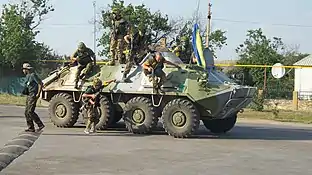
The government military operation to counter DPR and LPR forces in the Donbas is called the "Anti-Terrorist Operation" (ATO). It is led by the Anti-Terrorist Centre, a division of the Security Service of Ukraine (SBU).[109][110] The SBU is the main intelligence service of Ukraine.
Pro-government paramilitaries
At least 50 pro-Ukrainian volunteer units have been formed and fought against the Donbas People's Militia and other insurgent groups.[111] These forces include the Donbas Battalion, Azov Battalion, Kharkiv Battalion, and Oleh Lyashko's militia.[112] Some of these units work under contract with the National Guard of Ukraine.[113]
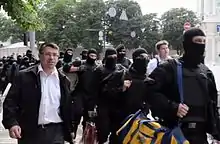
These units took active participation in the military campaign. For example, the town of Shchastia in Luhansk Oblast was taken by the Aidar Battalion on 9 July,[114] and Azov Battalion, together with other units, recaptured Mariupol from pro-Russian separatists forces in June 2014.[115]
Some of the volunteer battalions belong to Right Sector.[116] It lost 12 fighters when it was ambushed outside Donetsk in August 2014. Right Sector leader Dmytro Yarosh vowed his group would avenge the deaths.[117]
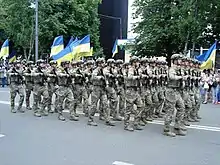
Foreign fighters mainly from Belarus, Georgia and Russia (about 100 men from each country) have joined the volunteer battalions,[118][119][120][121] as well as volunteers from the United States, France, Germany, Norway, Sweden, Georgia, Poland, Spain, the Czech Republic, the United Kingdom, Croatia, Italy and Canada.[118] The Foreign Ministry of Russia asked the governments of Sweden, Finland, the Baltic states, and France to conduct a thorough investigation into reports of mercenaries from their countries serving Ukrainian forces, following a story in the Italian newspaper Il Giornale.[122][123][124]
Chechen opponents of the Russian government,[125] including Chechen military commander Isa Munayev, were fighting pro-Russian separatists in Ukraine for the Ukrainian government.[126]
At least three volunteer battalions composed mostly of people from the Caucasus and Central Asia are fighting against pro-Russian separatists.[127] They include Muslims from states that were part of the Soviet Union, including Uzbeks, Balkars and Crimean Tatars.[128][129]
Belarusian volunteers fighting on the side of Ukraine created the Tactical group "Belarus", as well as the "Pahonia" detachment, named after the old Belarusian coat of arms.[130][131] On March 28, 2016, a Monument to the Belarusians who died for Ukraine was unveiled in Kyiv. It lists the names of Mykhailo Zhyznevsky, who died during the Euromaidan events, as well as Ales Cherkashin and Vitaly Tilizhenko, the dead volunteers of the Tactical group "Belarus".[132] During the 2022 Russian invasion of Ukraine, Belarusian volunteers founded the Kastuś Kalinoŭski Battalion.[133]
There are ongoing attempts by the Ukrainian Armed Forces to integrate volunteer battalions into the regular army and indeed many of the volunteers fighting in those groups were drafted into the army.[134] The status of the remaining volunteer units remain legally ambiguous.[134]
See also
References
- "The Ukrainian Week". ukrainianweek.com. Archived from the original on 24 March 2022. Retrieved 3 March 2018.
- Vasovic, Aleksandar; Tsvetkova, Maria (15 May 2014). "This Elusive Muscovite With 3 Names Has Taken Control of Ukraine Rebels". Business Insider. Australia. Archived from the original on 12 August 2015. Retrieved 20 May 2014.
- Rachkevych, Mark (26 April 2014). "Alleged Russian Colonel Strelkov makes public appearance as self-proclaimed chief of 'Donbass People's Militia'". Kyiv Post. Archived from the original on 26 April 2014.
- "Ukraine's Separatist Phantom Comes Out of the Shadows". The New York Times. 26 April 2014.
- "Ukraine gunmen seize two buildings in Sloviansk". BBC News. 12 April 2014. Archived from the original on 2 March 2022. Retrieved 12 April 2014.
- "Приїжджі загарбники в Краматорську назвалися "народним ополченням"". Ukrainska Pravda. 12 April 2014. Archived from the original on 14 November 2014. Retrieved 19 April 2021.
- Oliphant, Roland (12 April 2014). "Fears of full-scale Russian invasion as eastern Ukraine cities toppled". The Daily Telegraph. London. Archived from the original on 7 December 2017. Retrieved 19 April 2021.
- Shynkarenko, Oleg (14 April 2014). "Russia Tells 'Tourists' How to Go Fight in Ukraine". The Daily Beast. Archived from the original on 21 March 2017. Retrieved 19 April 2021.
- Штурмом міліції в Горлівці керував російський підполковник [Militia captured in Horlivka was led by a Russian Colonel] (in Ukrainian). Ukrainian Pravda. 14 April 2014. Archived from the original on 26 March 2015. Retrieved 28 July 2015.
- "Ukraine: Photos show undercover Russian troops". CNN. 21 April 2014. Archived from the original on 22 April 2021. Retrieved 19 April 2021.
- Claire Bigg (17 May 2014). "Pro-Russian Militias Are Torturing People in Eastern Ukraine". Business Insider. Archived from the original on 4 February 2016. Retrieved 28 July 2015.
- Dergachev, Vladimir (23 May 2014). Националистов здесь много [There are many nationalists here] (in Russian). Gazeta.ru. Archived from the original on 27 May 2014. Retrieved 12 June 2014.
- Du wachst auf und plötzlich bist du im Krieg Archived 8 March 2021 at the Wayback Machine. Die Welt. 29 July 2014
- "Kremlin-backed rebels form Novorossiya army". Kyiv Post. 16 September 2014. Archived from the original on 18 October 2016. Retrieved 19 September 2014.
- Luhn, Alec (13 April 2014). "East Ukraine protesters joined by miners on the barricades". The Guardian. Archived from the original on 21 October 2014. Retrieved 3 March 2017.
- "У самопровозглашенной Донецкой республики появилась новая армия – Русская православная (In the self-proclaimed republic of Donetsk, a new army – Russian Orthodox)". InfoResist (in Russian). 10 May 2014. Archived from the original on 11 May 2019. Retrieved 13 July 2014.
- "Meet the Russian Orthodox Army, Ukrainian Separatists' Shock Troops". NBC News. 16 May 2014. Archived from the original on 22 July 2019. Retrieved 13 July 2014.
- "В Мариуполе бойцы Ляшко задержали представителя "Русской православной армии" (In Mariupol Ljashko fighters detained by "Russian Orthodox army")". Mariupol News (in Russian). 13 June 2014. Archived from the original on 24 July 2018. Retrieved 13 July 2014.
- "Репортаж из казармы Русской Православной Армии (Reports of Russian Orthodox Army barracks)" (in Russian). Dialog.ua. 17 June 2014. Archived from the original on 11 May 2019. Retrieved 13 July 2014.
- Daryna Krasnolutska; Tony Capaccio; Volodymyr Verbyany (27 July 2014). "Ukraine Army Advances as EU Plans Tougher Putin Sanctions". Bloomberg News. Archived from the original on 11 May 2019. Retrieved 16 January 2015.
- BACZYNSKA, GABRIELA (1 June 2014). "More foreign fighters break cover among Ukraine separatists". Reuters. Archived from the original on 2 June 2014.
- Weaver, Courtney (29 May 2014). "Ukraine crisis: Paramilitaries seize Donetsk rebels' HQ". Financial Times. Archived from the original on 20 March 2017. Retrieved 12 June 2014.
- Andrew Roth (4 June 2014). "A Separatist Militia in Ukraine With Russian Fighters Holds a Key". The New York Times. Archived from the original on 10 October 2014. Retrieved 7 November 2014.
- Claire Bigg (30 May 2014). "Vostok Battalion, A Powerful New Player in Eastern Ukraine". Radio Free Europe/Radio Liberty. Archived from the original on 31 May 2014. Retrieved 22 June 2014.
- Oliphant, Roland (29 May 2014). "Ukraine's rebels in crisis after Donetsk 'coup'". The Daily Telegraph. London. Archived from the original on 8 June 2014. Retrieved 12 June 2014.
- Stephen Ennis (20 June 2014). "UK journalist caught up in Russia-Ukraine media battle". BBC. Archived from the original on 24 February 2015. Retrieved 22 June 2014.
- Tsvetkova, Marko Djurica, Maria (29 September 2014). "American becomes a rebel with a cause in east Ukraine". Reuters. Archived from the original on 31 August 2021. Retrieved 31 August 2021.
{{cite news}}: CS1 maint: multiple names: authors list (link) - Murauskaite, Egle (February 2020). "FOREIGN FIGHTERS IN UKRAINE: ASSESSING POTENTIAL RISKS" (PDF). Vilnius Institute. Archived (PDF) from the original on 17 July 2021. Retrieved 30 August 2021.
- Salem, Harriet (31 May 2014). "Ice Cream, Corpses, and the Big Bear: Repatriating Dead Russians From Ukraine". Vice News. Archived from the original on 31 May 2014. Retrieved 31 May 2014.
- "Interview: I Was A Separatist Fighter In Ukraine". Radio Free Europe/Radio Liberty. 13 July 2014. Archived from the original on 25 July 2016. Retrieved 16 October 2016.
- Alec Luhn (24 February 2015). "Ukraine separatists celebrate Soviet holiday in Donetsk". The Guardian. Archived from the original on 22 March 2015. Retrieved 6 March 2015.
- "Ukraine's government has lost control of east, says acting president | The Guardian". The Guardian. 30 April 2014. Archived from the original on 1 July 2014. Retrieved 27 May 2014.
- 15,000 police ‘defected to Donbas separatists’ Archived 21 April 2021 at the Wayback Machine. UNIAN. 16 October 2014.
- "Russians Find Few Barriers to Joining Ukraine Battle Archived 21 June 2019 at the Wayback Machine". The New York Times. 9 June 2014.
- "Ukraine: Common history pulls in aid from west Russia Archived 25 December 2018 at the Wayback Machine". BBC News. 23 June 2014.
- "Historical Dictionary of Ukraine Archived 23 January 2023 at the Wayback Machine". Ivan Katchanovski, Zenon E. Kohut, Bohdan Y. Nebesio, Myroslav Yurkevich (2013). p.135. ISBN 081087847X
- "Interview with the Ataman Graschenko, Lieutenant-General of the Cossack troops for the District of the Great Don Army". National Union of Cossacks. Archived from the original on 14 August 2014. Retrieved 14 August 2014.
- "Установлены личности "активистов" с Востока Украины, участвовавших в событиях в Крыму". Korrespondent. 23 April 2014. Archived from the original on 19 April 2021. Retrieved 19 April 2021.
- Babiak, Mat (22 April 2014). "Insurgents Identified: The Green Men of VKontakte". Ukrainian Policy. Archived from the original on 23 April 2014.
- Shuster, Simon (24 April 2014). "Exclusive: Meet the Pro-Russian Separatists of Eastern Ukraine". Time. Archived from the original on 3 May 2014. Retrieved 19 April 2021.
- Shuster, Simon (12 May 2014). "Meet the Cossack 'Wolves' Doing Russia's Dirty Work in Ukraine". Time. Archived from the original on 8 December 2017. Retrieved 19 April 2021.
- "Под Краснодоном погиб кубанский казак Пономарев, товарищ Бабая – соцсети – Новости". m.news.bigmir.net. 28 August 2014. Archived from the original on 24 February 2021. Retrieved 19 April 2021.
- Young, Cathy (21 May 2014). "Fascism Comes to Ukraine – From Russia". Archived from the original on 21 May 2014. Retrieved 19 April 2021.
- "Russian Cossacks Arrested in Luhansk: Ukrainian security forces detain Kremlin-backed insurgents". Archived from the original on 16 June 2014. Retrieved 12 June 2014 – via YouTube.
- Weaver, Courtney (27 May 2014). "Chechens join pro-Russians in battle foreast Ukraine". Financial Times. Archived from the original on 29 November 2021. Retrieved 2 September 2021.
- Roth, Andrew; Tavernise, Sabrina (28 May 2014). "Russians Revealed Among Ukraine Fighters". The New York Times. Archived from the original on 21 February 2022. Retrieved 19 April 2021.
- "Interview: I Was A Separatist Fighter In Ukraine". Radio Free Europe/Radio Liberty. 13 July 2014. Archived from the original on 25 July 2016. Retrieved 19 April 2021.
- "Среди террористов в Славянске замечены чеченские боевики – СМИ : Новости УНИАН". Ukrainian Independent Information Agency. Archived from the original on 9 May 2014. Retrieved 14 May 2014.
- Catherine A. Fitzpatrick (9 May 2014). "Russia This Week: Surge of Nationalism on Victory Day (5–9 May) | The Interpreter". Interpretermag.com. Archived from the original on 13 May 2014. Retrieved 14 May 2014.
- Goble, Paul (8 May 2014). "Grozny Forcing Chechens to Fight for Russian Side in Ukraine". The Interpreter. Archived from the original on 8 May 2014.
- "Kadyrov Denies Chechen Military Involvement in Ukraine Fighting". Radio Free Europe/Radio Liberty. 9 May 2014. Archived from the original on 14 May 2014. Retrieved 14 May 2014.
- "Ukraine fails to prevent illegal border crossing by a group of armed men". Kyiv Post. 24 May 2014. Archived from the original on 12 June 2014. Retrieved 12 June 2014.
- Canada (26 May 2014). "Kiev decries Russia's frosty welcome for new president". The Globe and Mail. Toronto. Archived from the original on 27 May 2014. Retrieved 12 June 2014.
- "Ukrainian army battles Kremlin-backed separatists in Donetsk; at least one civilian killed in crossfire (LIVE UPDATES)". Kyiv Post. 26 May 2014. Archived from the original on 22 July 2015. Retrieved 19 April 2021.
- "ВИДЕО. ФОТО. В Донецке Кавказцев встречали криками "Герои!" – Info Resist". Archived from the original on 20 October 2014. Retrieved 14 October 2014.
- "Pro-Russian separatists from the "East" battalions speak with local residents during a rally in the eastern city of Donetsk May 25, 2014". ABC News. 25 May 2014. Archived from the original on 18 November 2014. Retrieved 6 March 2015.
- Ed Payne; Nick Paton Walsh (26 May 2014). "Ukraine billionaire Petro Poroshenko leads in early election results". CNN. Archived from the original on 11 March 2015. Retrieved 6 March 2015.
- "Kadyrov Denies Chechen Military Involvement in Ukraine Fighting". RadioFreeEurope/RadioLiberty. Archived from the original on 14 April 2016. Retrieved 19 April 2021.
- ""Абвер" подтвердил, что террористам на Донбассе помогают чеченцы – УКРИНФОРМ". Archived from the original on 6 September 2014. Retrieved 14 October 2014.
- Salem, Harriet (27 May 2014). "Fighting in Ukraine Escalates as Militia Groups Flock to Donetsk". VICE News. Archived from the original on 22 October 2017. Retrieved 19 April 2021.
- Кадыров: 74 тысячи чеченцев готовы выехать, чтобы навести порядок в Украине [Kadyrov: 74 thousand Chechens are ready to go to put things in order in Ukraine]. LB.ua (in Russian). 1 June 2014. Archived from the original on 19 April 2015. Retrieved 6 March 2015.
- Allison Quinn; Kyiv Post staff (8 May 2015). "Suspicions abound as Chechen fighters make mysterious exit from Donbas battlefield". Kyiv Post. Archived from the original on 22 July 2015. Retrieved 28 July 2015.
- Gassyeva, Dina (4 May 2014). Добровольцы из Южной Осетии намерены помочь юго-востоку Украины (in Russian). RIA Novosti. Archived from the original on 6 May 2014. Retrieved 6 May 2014.
- В Донецк прибыли боевики из Осетии? [Did militants come to Donetsk from Ossetia?] (in Russian). Novosti.dn.ua. 9 March 2014. Archived from the original on 13 May 2014. Retrieved 14 May 2014.
- Госпогранслужба: среди террористов есть абхазцы [State Border Guard Service: there Abkhazians among the terrorists] (in Russian). LB.ua. 28 May 2014. Archived from the original on 29 May 2014. Retrieved 30 August 2014.
- @Russ_Warrior (22 June 2017). "Dimitrije Saša Karan from #Serbia has died 2 days ago, he joined Russian Forces as volunteer to fight against terro…" (Tweet) – via Twitter.
- "At least 100 Serbs fight in Ukraine on pro-Russian side". inSerbia. 6 August 2014. Archived from the original on 12 October 2017. Retrieved 30 August 2014.
- "Serbia opens 45 cases against Serbian mercenaries fighting abroad, incl. in Donbas". Ukrainian Independent Information Agency. 12 November 2017.
- "'Novinarstvo' srpskog dobrovoljca iz Ukrajine". Radio Slobodna Evropa (in Serbo-Croatian). Archived from the original on 26 January 2022. Retrieved 11 April 2021.
- "Sniper Deki who turned into a journalist". www.ukrinform.net. Archived from the original on 26 January 2022. Retrieved 11 April 2021.
- "Московиты выдали нашего клиента Сербии. Несите следующего". Myrotvorets News (in Ukrainian). 17 May 2020. Archived from the original on 21 October 2020. Retrieved 17 May 2020.
- "Ukraine war pulls in foreign fighters". BBC News. 31 August 2014. Archived from the original on 1 September 2014. Retrieved 1 September 2014.
- "Ukraine crisis: Rebel fighters 'trained in Russia'". BBC News. 16 August 2014. Archived from the original on 23 December 2021. Retrieved 1 September 2014.
- "Nasi w Donbasie. Międzynarodówka bije się na ukraińskiej wojnie". wiadomosci.dziennik.pl. 30 September 2014. Archived from the original on 7 October 2014. Retrieved 14 October 2014.
- "Ukraine conflict: Spanish suspects held for 'joining rebels'". BBC News. 27 February 2015. Archived from the original on 1 March 2015. Retrieved 6 March 2015.
- Raphael Minder (27 February 2015). "Spain Arrests 8 on Suspicion of Fighting for Rebels in Ukraine". The New York Times. Archived from the original on 4 March 2015. Retrieved 6 March 2015.
- Rodríguez, Jorge A. (27 February 2015). "Eight Spaniards arrested after returning from combat in Ukraine". El País. Archived from the original on 4 November 2019. Retrieved 19 April 2021.
- Ortega Dolz, Patricia (27 February 2015). "We fought together, communists and Nazis alike, for the liberation of Russia". El País. Archived from the original on 17 March 2015. Retrieved 19 April 2021.
- "В Донбассе воюют более сотни граждан Германии – СМИ". Liga News. 15 March 2015. Archived from the original on 28 November 2021. Retrieved 19 April 2021.
- "Kazakh Citizen Sentenced For Joining Russia-Backed Separatists in Ukraine". Radio Free Europe/Radio Liberty. 27 April 2015. Archived from the original on 9 March 2016. Retrieved 19 April 2021.
- Tomiuc, Eugen (12 February 2016). "Moldova Indicts, Sentences Individuals Who Fought As Mercenaries in Ukraine". Radio Free Europe/Radio Liberty. Archived from the original on 20 June 2016. Retrieved 19 April 2021.
- "Latest from OSCE Special Monitoring Mission (SMM) to Ukraine based on information received as of 19:30 (Kyiv time), 2 August 2015". OSCE. 3 August 2015. Archived from the original on 23 February 2022. Retrieved 15 September 2015.
- "Russian military shelled Ukraine from mid-July, report says". The Guardian. 11 March 2015. Archived from the original on 19 July 2021. Retrieved 11 March 2015.
- Igor Sutyagin (March 2015). "Briefing Paper: Russian Forces in Ukraine" (PDF). Royal United Services Institute. Archived from the original (PDF) on 8 May 2015. Retrieved 11 March 2015.
- "Putin denies Russian troops are in Ukraine". Agence France-Presse. Archived from the original on 19 April 2021. Retrieved 19 April 2021.
- Slv, Igor (30 July 2016). "50,000 Russian citizens fought in Donbas war: separatist ex-leader". Euromaidan Press. Archived from the original on 9 October 2016. Retrieved 16 October 2016.
- "Former Ukraine rebel head starts support group for Russian fighters". Yahoo News (AFP). 27 August 2015. Archived from the original on 17 April 2021. Retrieved 16 April 2021.
- "OSCE drone downed after it spotted Russian military movement by night in Ukraine - Human Rights in Ukraine". Human Rights in Ukraine. Archived from the original on 29 October 2018. Retrieved 29 October 2018.
- "New convoy of Russian military trucks caught entering Ukraine by night". Human Rights in Ukraine. Archived from the original on 8 June 2019. Retrieved 10 June 2019.
- "Spot Report 6/2021: SMM long-range UAV unable to take off due to dual GPS signal interference". osce.org. Archived from the original on 15 April 2021. Retrieved 15 April 2021.
- "Latest from OSCE Special Monitoring Mission (SMM) to Ukraine based on information received as of 19:30 (Kyiv time), 16 August 2015". www.osce.org. Archived from the original on 9 June 2021. Retrieved 16 April 2021.
- "Latest from OSCE Special Monitoring Mission (SMM) to Ukraine, based on information received as of 19:30, 15 June 2016". www.osce.org. Archived from the original on 16 April 2021. Retrieved 16 April 2021.
- "Daily Report 60/2020". www.osce.org. Archived from the original on 16 April 2021. Retrieved 16 April 2021.
- "Latest from the OSCE Special Monitoring Mission to Ukraine (SMM), based on information received as of 19:30, 10 August 2018". www.osce.org. Archived from the original on 15 February 2022. Retrieved 16 April 2021.
- Quinn, Allison (30 March 2016). "Vladimir Putin sent Russian mercenaries to 'fight in Syria and Ukraine'". The Telegraph. ISSN 0307-1235. Retrieved 12 October 2023.
- "Россия тогда ввела войска и спасла нас!" Ходаковский признал, что РФ в 2014 вторглась в Украину, retrieved 12 October 2023
- ""Armed Conflict in Ukraine: Military Support for DPR and LPR Illegal Armed Groups by the Russian Federation"" (PDF). www.ohchr.org. Archived (PDF) from the original on 30 July 2021. Retrieved 27 September 2021.
- ""Unleashing the PMCs and Irregulars in Ukraine: Crimea and Donbas"". jamestown.org. Archived from the original on 26 September 2021. Retrieved 27 September 2021.
- "Abandoned Donbas Battalion fights on". Kyiv Post. 24 August 2014. Archived from the original on 25 August 2014. Retrieved 27 August 2014.
- "Why is Ukraine's Army So Appallingly Bad?". The New Republic. 9 May 2014. Archived from the original on 4 July 2014. Retrieved 20 September 2014.
- In the Army Now: Answering Many Why's Archived 8 January 2015 at the Wayback Machine, The Ukrainian Week (8 July 2014)
- Рингис А. (31 July 2015). Бэк-офис армии. Как работают альтернативные службы тыла [Army Back Office. How do alternative service of the rear work]. Ukrayinska Pravda (in Russian). Archived from the original on 19 April 2016.
- Kramer, Andrew E. (22 November 2014). "With Borscht and Rifle Scopes, Volunteers Power Ukraine Forces". The New York Times. Archived from the original on 24 November 2014. Retrieved 24 November 2014.
- Тохтарова І. М. (2014). Волонтерський рух в Україні: шлях до розвитку громадянського суспільства як сфери соціальних відносин [Volunteer movement in Ukraine: way to development of civil society as a sphere of social relations] (PDF). Теорія та практика державного управління і місцевого самоврядування (in Ukrainian) (2, 2014). Archived from the original on 19 May 2016.
{{cite journal}}: CS1 maint: unfit URL (link) - Natalia Zinets (4 February 2016). "Ukraine struggles to recruit soldiers for war in east". Reuters. Archived from the original on 14 February 2016. Retrieved 13 February 2016.
- "Number of Ukrainian soldiers participating in Anti-Terrorist Operation revealed". Ukraine Today. Archived from the original on 15 April 2016. Retrieved 14 April 2016.
- Ukraine's Toughest Fight: The Challenge of Military Reform Archived 3 October 2018 at the Wayback Machine, Carnegie Endowment for International Peace (22 February 2018)
- "Rada of Ukraine created the National Guard (English translation of title)". rbc.ua. 13 March 2014. Archived from the original on 26 February 2021. Retrieved 19 April 2021. (Article is in Ukrainian)
- "Ukraine launches 'anti-terrorist' operation, one killed". Haarets. 13 April 2014. Archived from the original on 13 April 2014.
- Nick Paton Walsh; Tim Lister; Steve Almasy (14 April 2014). "U.N. Security Council meets as Ukraine 'teeters on the brink'". CNN. Archived from the original on 9 August 2015. Retrieved 28 July 2015.
- "Ukraine underplays role of far right in conflict". BBC News. 15 December 2014. Archived from the original on 2 June 2018. Retrieved 28 January 2015.
- "Militia backed by presidential candidate Lyashko takes credit for assassination of Russian-backed separatist". Kyiv Post. 23 May 2014. Archived from the original on 24 May 2014. Retrieved 21 June 2014.
- Роз'яснення щодо статусу спецпідрозділу "Азов" [Clarification regarding the status of "Azov" Special Forces] (in Ukrainian). ngu.gov.ua. 23 April 2015. Archived from the original on 9 July 2015. Retrieved 8 August 2015.
- "'Happiness' stuck under crossfire in eastern Ukraine". Kyiv Post. 20 July 2014. Archived from the original on 20 July 2014. Retrieved 20 July 2014.
- Bojan Pancevski (11 May 2014). "Kiev lets loose Men in Black". The Sunday Times. London. Archived from the original on 13 May 2014. Retrieved 22 July 2014.
- "Donbas battalion loses 4 in Ilovaisk assault". Kyiv. Ukrinform. 11 August 2014. Archived from the original on 21 March 2017. Retrieved 19 April 2021.
The anti-terrorist operation (ATO) forces ... began to storm pro-Russian militants entrenched in Ilovaisk.... The assault began with the participation of the volunteer battalions Donbas, Azov, Shakhtarsk, and the Right Sector, ... in conjunction with the ATO forces.
- Natalia Zinets (13 August 2014). "Twelve Ukrainian nationalist fighters killed in separatist ambush". Reuters. Archived from the original on 8 February 2022. Retrieved 26 October 2015.
- Olena Goncharova (18 October 2015). "Foreign fighters struggle for legal status in Ukraine". Kyiv Post. Archived from the original on 18 October 2015.
- "Foreign nationals fighting for Ukraine in Donbas demand passports in exchange for their service". Ukraine Today. 19 October 2015. Archived from the original on 6 March 2016. Retrieved 26 October 2015.
- Peterson, Nolan (4 August 2015). "Why a Russian Is Fighting for Ukraine". Newsweek. Archived from the original on 20 February 2022. Retrieved 26 October 2015.
- "They Came to Fight for Ukraine. Now They're Stuck in No Man's Land". Foreign Policy. 19 October 2015. Archived from the original on 20 February 2022. Retrieved 26 October 2015.
Megrelidze, Sophiko (23 January 2015). "Georgians in Ukraine fight shadow war". Associated Press. Archived from the original on 20 February 2022. Retrieved 19 April 2021. - "Russia demands condemnation of mercenaries' activity in eastern Ukraine". TASS. Archived from the original on 4 February 2016. Retrieved 14 October 2014.
- "Russia demands investigation into claims Finns joined fighting in Ukraine". Yle Uutiset. Archived from the original on 23 October 2014. Retrieved 14 October 2014.
- Комментарий МИД России по поводу участия иностранных наемников в войне на Востоке Украины [Russian MFA commentary on the participation of foreign mercenaries in the war in the east of Ukraine] (in Russian). Ministry of Foreign Affairs (Russian Federation). 21 July 2014. Archived from the original on 14 July 2015. Retrieved 7 November 2014.
- "We like partisan warfare.' Chechens fighting in Ukraine – on both sides". The Guardian. 24 July 2015. Archived from the original on 27 February 2022. Retrieved 29 September 2016.
- "Chechens join Ukraine fight against Russian-backed separatists". The Irish Times. 16 December 2014. Archived from the original on 13 March 2022. Retrieved 19 April 2021.
- "Foreign Islamic Battalions Fight To Defend Ukraine Against Rebels Archived 21 April 2021 at the Wayback Machine". International Business Times. 7 July 2015.
- "Islamic Battalions, Stocked With Chechens, Aid Ukraine in War With Rebels Archived 19 April 2021 at the Wayback Machine". The New York Times. 7 July 2015.
- "To Defeat Russia, Ukraine Creates Muslim Military Unit Made Up Of Crimean Tatars Archived 16 April 2021 at the Wayback Machine". International Business Times. 3 August 2015.
- "Ян Мелнікау: Без вільної України не буде вільної Білорусі". Archived from the original on 18 November 2018. Retrieved 30 August 2021.
- "Участь в АТО візьме добровольчий загін білорусів «Пагоня»". Archived from the original on 5 October 2017. Retrieved 15 March 2022.
- "У Києві відкрили пам'ятник білорусам, загиблим на Майдані та в АТО". Archived from the original on 31 March 2016. Retrieved 15 March 2022.
- Max Bearak (1 April 2022). "A Belarusian battalion fights in Ukraine 'for both countries' freedom'". Washington Post. Archived from the original on 1 April 2022. Retrieved 2 April 2022.
- Ukraine's “Invisible” Volunteer Fighters Archived 4 February 2021 at the Wayback Machine, Hromadske.TV (18 November 2018)
German military criticized over Ukrainian medical evacuation flights Archived 30 December 2018 at the Wayback Machine, Deutsche Welle (09.08.2018)
